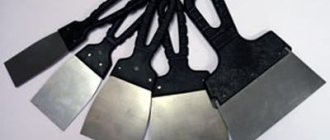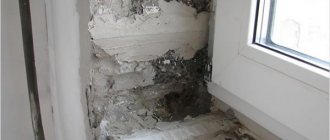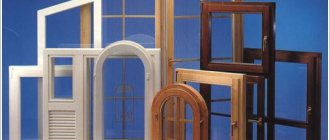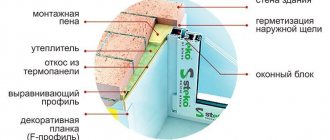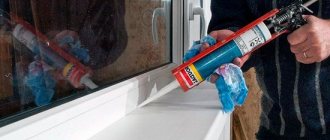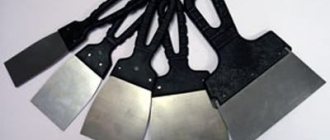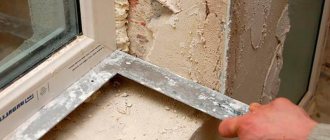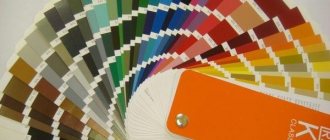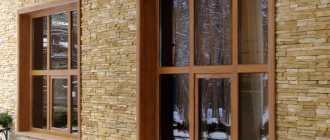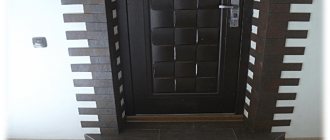Foam plastic slopes: material features and work technology
The main task of slopes is to protect housing from moisture and prevent heat loss.
Not so long ago, it was customary to seal slopes with plaster and concrete mortar. But, over time, the concrete solution begins to crumble, the slopes become unattractive and do not properly protect the apartment from external factors.
Today, covering and insulating window slopes with foam plastic is gaining more and more popularity. Next, we will tell you why the material is so good, and also describe in detail the installation technology.
Make the right choice
Slopes are an additional source through which heat flows out of the room. Also, due to the formation of condensation on them, the room may smell damp or moldy. This issue needs to be resolved immediately, but less effort will have to be made at the initial stage of window installation.
Layer-by-layer arrangement of materials
In this case, modern insulating materials are used:
- polyurethane foam;
- mineral or basalt wool;
- foam boards;
- rolls of foil fiberglass;
- sandwich panels.
It is also possible to insulate the slopes of plastic windows with isover (fiberglass). Preference is given to any method, based on technological capabilities and while maintaining an aesthetic appearance.
Izover for slope insulation
When using polyurethane foam, you will need to protect it from exposure to ultraviolet rays and moisture. Otherwise, it will collapse and turn into dust.
Treatment of joints with polyurethane foam
If you insulate the slopes of plastic windows with your own hands using polystyrene foam, you need to know that this porous material is capable of accumulating moisture, which in such a situation would be undesirable. It is preferable to choose penoplex slabs, which show increased efficiency, but have a higher cost.
Another high-quality material for such work is fiberglass. It blocks the circulation of air, moisture and is even a dielectric. However, working with her in such conditions is problematic.
It is worth considering that the result will be better if the work is carried out with slopes both on the inside, indoors, and on external surfaces located outside.
Options for slopes of PVC plastic windows
In severe frosts, without reliable insulation of the slopes of plastic windows from the inside and outside, you can even get drizzle on the walls. Therefore, such an operation should not be neglected.
Working indoors
After installing a new plastic window, the owners immediately take care of ensuring the aesthetic appearance of the part of the room being repaired. It is recommended at this stage, before finishing, to insulate problem areas using one of the types of thermal liners. They are mounted on the internal or external surface, and then plastering and cladding are carried out.
The overall parameters of thermal liners depend on climatic conditions, as well as the thermal conductivity of the building wall. The effectiveness of insulating the slopes of plastic windows with your own hands, as in the video, depends on the degree of adhesion of the thermal insulator to the wall surface. There should be no swelling or air layer allowed in this gap.
Method for sealing cracks from the inside
You can use one of the options that are doable even if you work on your own.
- After installing the window, insulation is attached to the resulting planes of the window opening, which, after fixing, must cover the seam between the frame and the wall. This creates a slight overlap on the front of the frame. If soft insulation, such as basalt wool, is used, then the surface is covered with a layer of plasterboard, then the outer part must be puttied and painted. When extruded polystyrene foam boards are used, plasterboard sheets are not installed. The horizontal part of the slopes is also insulated. After installing the slabs, a plaster mesh must be applied to the front side. Prepared cement mortar is applied on top of it. The final layer is finishing putty.
- It will be possible to achieve high-quality insulation of the slopes of plastic windows as in the video by installing sandwich panels. This material includes a thermal insulation layer. This type of work is usually called “clean”. This insulation is perfect for plastic windows in terms of its style, because similar decorative surfaces and frames are appropriately in harmony with each other. To create better contact, you can place an additional layer of mineral wool between the panel and the slope.
Please note that it is recommended to use only stone (basalt) wool as insulation. It is made from melt and is absolutely safe for indoor use. Unlike stone wool, glass wool is made from molten glass and quartz sand, which allows it to be used only for insulating rooms outside.
VIDEO: Which slopes for PVC windows are better - plastic, plaster or plasterboard
Use of polystyrene foam
One of the common options is the use of polystyrene foam due to its affordable cost and relative ease of working with it. Before using it, you will need to prepare a flat surface. This is done after installing the plastic frame. The slopes are plastered with cement mortar, including areas with polyurethane foam. After drying, we treat it with an antibacterial solution that prevents the appearance of fungus, and prepare foam plates about 5 mm thick.
The advantages of polystyrene foam when designing slopes
A window slope is a specialized system that can close the opening that forms between the window frame and the facade. It is customary to make slopes after replacing the window unit. As we have already said, the purpose of installing slopes is moisture and heat insulation. Few specialists, after installing a new window unit, suggest immediately making slopes. But, due to such negligence, the polyurethane foam (the material on which the window unit is supported) quickly dries out, gaps form, etc.
Window slopes made of foam plastic
Previously, to seal slopes, craftsmen used various construction solutions, such as plaster, but such finishing material was not particularly reliable. Also, many people prefer plastic panels, but this material is absolutely not suitable for such work, because atmospheric influences can deform it. Today, slopes made of plastic, foam and metal, which have the following advantages, are becoming increasingly popular:
- They last a long time in use.
- Resistant to rust.
- Not deformed.
- Excellent retention of heat in the house.
- Easy to install.
- They have an attractive appearance.
Do-it-yourself warm slopes on plastic windows
A modern plastic window is a design that reduces heat loss through the window opening to almost zero. However, to reliably protect the room from the entry of cold air, it is also necessary to take care of insulating the slopes. Without these additional works, even the latest double-glazed windows will not provide a comfortable microclimate in the room in winter.
- Why is it necessary to insulate slopes?
- Materials used
- Preparatory work
- Insulation of slopes inside with foam plastic or penoplex
- Also to help - a short video instruction:
- Combined insulation inside
- Exterior works
- Video on the topic:
Why is it necessary to insulate slopes?
Often, after replacing windows, they are limited to only decorative finishing of the slopes, which is wrong and can lead to problems in the near future, because:
- The seams between the wall and the glass unit are filled with polyurethane foam. But this material is not sufficiently resistant to high humidity, ultraviolet radiation and low temperatures. Very quickly, unprotected polyurethane foam will begin to deteriorate under the influence of weather conditions , which will lead to heat loss through voids in the seams.
- Numerous cracks on untreated surfaces of slopes are a common cause of heat leakage from a room.
- Moisture can accumulate in the voids between the wall and decorative panels , which means condensation may form.
Plaster slopes become damp in winter
Plastering slopes without additional insulation is a kind of “first aid”. This finishing method will help you out for a while if, immediately after installing double-glazed windows, you do not have the opportunity and time to do quality work. But in the long run this is not the best solution. Small cracks will form on such a surface, which will require constant minor adjustments. In addition, such slopes do not have good thermal insulation. We will soon have to return to the issue of serious insulation.
It is advisable to carry out the work immediately after installing the windows in the warm season. During the cold season, this will be more problematic, since many adhesives and sealants can only be worked at a certain temperature.
Materials used
The range of materials used to insulate slopes on your own is quite diverse. Each of them has its own advantages and differs in installation and operation features:
- Mineral wool (not to be confused with glass wool - this material is highly undesirable to use for interior work). The main advantages are excellent heat and sound insulation properties. Disadvantage: high moisture absorption. If you notice that the windows are “sweating”, then it is better to abandon this type of insulation, as over time this can lead to the formation of mold and fungi.
The easiest way to insulate using mineral wool
- Styrofoam. The material is inexpensive and easy to work with, which is why it is popular in various types of work.
- Penoplex. It has improved performance characteristics compared to polystyrene foam, but it is also more expensive.
- Sandwich panels. Modern and most convenient type of material. Already includes thermal insulation and protective layers. It harmoniously complements plastic windows and usually fits into any room design. Cons: relatively expensive.
The choice of the preferred material is made based on climatic conditions, the general condition of the walls of the house, the material capabilities of the owner, and the skill level of workers.
Select the required thickness of insulation.
Preparatory work
Regardless of which insulation method and type of material are chosen, first of all it is necessary to conduct a visual inspection of the window structure and carefully check the condition of the installation seams. If the double-glazed window was installed a long time ago, and the installation seam was not protected, then most likely the foam has already begun to collapse and crumble. You can identify problem areas using a lighter. Run it along the entire perimeter of the window. Where the flame deflects is where the leak occurs. These areas need to be cleaned and re-foamed. After hardening, cut off excess polyurethane foam.
Insulation of slopes inside with foam plastic or penoplex
Sheets of foam plastic or penoplex are the most common types of materials for insulating slopes. Work using them is carried out after installation of the double-glazed window in the following sequence:
- Slopes and areas between the frame and the wall, filled with polyurethane foam, must be plastered with cement mortar.
- After drying, treat the surface with an antibacterial compound.
- Cut the insulation to the required size. It is better to cut a larger piece - the excess can be easily trimmed after installation.
- Sand the surface with sandpaper. Coat with special glue for foam plastic. If you use foam, don't apply a lot of adhesive coating. This type of insulation expands when heated - in hot summer times, a thick layer of adhesive may crack and the coating will lose its thermal insulation properties. Apply the prepared insulation to the slope, partially covering the window frame.
- After the insulation has been glued, we fix it with plastic umbrellas.
- The next step will be mesh reinforcement.
- Then, we place the perforated corner on the putty and align it directly to the level.
- Apply a decorative coating to the front part of the insulation in accordance with the repair concept. This can be drywall followed by painting, plastic panels, colored plaster.
Also to help - a short video instruction:
Combined insulation inside
The use of two or more different types of insulation gives the best results. For example, you can use mineral wool in combination with sandwich panels. Additionally, you can use foil thermal insulation. The technical process looks like this:
- As usual, carry out all the necessary preparatory work: clean the surfaces, level out potholes and cracks using sealant.
- Cover the installation seams with foil insulation; the material should extend onto adjacent walls.
- Secure the U-shaped profile for subsequent installation of slopes.
- Cut pieces of the required sizes from sheets of sandwich panels and secure them in the profile.
- The voids between the panels and the wall are filled with mineral wool.
- Install the finishing profile.
Instead of expensive sandwich panels, you can successfully use the foam sheets already described above. But it will require finishing decorative finishing.
Exterior works
To more reliably protect the room from heat loss, it is necessary to insulate the window slopes from the outside as well. The best material for these purposes is penoplex. You will also need a special sealant for exterior use. In a private house, you can do the work yourself, but in a multi-story house it is better to use the services of professionals.
The technological sequence of operations is as follows:
- Clean the surfaces of external slopes from dust, dirt, paint residues, finishing and building materials.
- Level with cement mortar and allow the layer to dry.
- Cut the insulation into pieces of the required size.
- Coat the sheets with glue and install them on the slopes. Additionally secure in several places with dowels.
- Mount the corners. Do not neglect this stage. As a result, you will receive not only insulated, but also smooth slopes.
- Treat the front surface of the penoplex with special glue and secure the reinforcing mesh.
- Level with putty.
- After drying, apply water-based paint or other finishing materials.
The issue of slope insulation should not be ignored. The microclimate in the house and the size of the electricity bills depend on how well and timely this is done. Moreover, the whole process can be carried out independently.
Video on the topic:
What are the features of polystyrene foam?
Polystyrene foam is a very common building material, which is increasingly used to insulate walls and even ceilings. Its main advantages are:
- affordability;
- environmental friendliness;
- resistance to the influence of external stimuli.
The table below shows the characteristics of the foam.
Slopes on windows made of polystyrene foam allow you not only to insulate your home, but also to make metal-plastic windows more attractive. Such material does not rust during operation and does not deform.
Important! According to the DIY installation technology, insulating slopes with polystyrene foam is very similar to installing drywall. But, if drywall is used exclusively as an internal finishing building material, then polystyrene foam can be safely used outside. You can make slopes from foam plastic inside the apartment, as well as slopes from foam plastic from the outside, as soon as the mounting foam, which is used to fill the voids after installing the window block, has dried.
When making window slopes with your own hands from foam plastic, please note that you need to fix the canvas along the entire perimeter of the window, also under the window sill. The main condition during finishing is to apply putty in more than one layer. Do not use an excessive amount of adhesive solution, because as a result of exposure to high temperatures, the foam will expand, after which cracks will appear. Due to such troubles, the structure will lose not only its thermal insulation properties, but also its attractiveness.
DIY polystyrene slopes (video)
Instructions for insulating internal and external window slopes
Korovin Sergey Dmitrievich
Master of Architecture, graduated from Samara State University of Architecture and Civil Engineering. 11 years of experience in design and construction.
Owners of old window structures seek to replace them with new plastic windows, wanting to ensure good thermal insulation of the room. In practice, replacing a window is only the first step, which must be followed by a second - in the form of finishing and insulating the slopes. Positive results directly depend on how to insulate the slopes of plastic windows inside and out so that the operation of the new frames brings exceptional benefits to the owners.
List of required materials and tools
And so, in order to finish the external or internal slope, you will need the following devices:
- Construction mixer for mixing the solution.
- Drill.
- Putty knife.
- Level.
- Knife (painting knife).
- Brush.
Necessary tools for installing slopes
To seal slopes, the following materials will be useful:
- Assembly adhesive.
- Foam sheets.
- Special dowels for fixing material (parachutes).
- Fiberglass mesh.
- Primer mixture.
- Perforated corner (for decorating corners).
Now you can start insulating and decorating window slopes.
We insulate the outside
For owners of apartments in high-rise buildings, it is always better to entrust the insulation of the slopes of plastic windows from the outside in the absence of a balcony to professional installers in order to avoid possible risks of falling from a height. If you have a balcony, do not forget about insurance and caution.
Scheme of insulating a slope from the outside with a mini-slab
So, how to properly insulate slopes from the outside:
- In the case of a new installation, first remove excess polyurethane foam and treat the surface with a primer that protects against fungus and mold.
- Plaster will be required if the window slopes are uneven.
- To improve thermal insulation, we choose Penoplex insulation. We cut the material into pieces of the required size, apply special glue and glue it to the surface. For strength, Penoplex can be secured with dowels with mushroom-shaped screws. Such parts do not break the structure of the material and hold it well on the vertical surface of the plastic window.
- Next comes the installation of a special corner.
- We apply glue to the insulated external slopes and place a fiberglass mesh in it, carefully leveling the surface. Let it dry a little and apply another layer of glue, then level it with a spatula.
- After the surface has completely dried, apply water-based paint.
The outer side of polystyrene foam, a layer of plaster and paint will not allow cold air to penetrate into the room, and warm slopes from the inside will shift the dew point towards the outer walls. After completing the street and interior work, the installation of warm slopes on the windows can be considered complete. Don’t forget: how to insulate the slopes of plastic windows from the street will largely determine the amount of heat in the room in winter, so take the time to carry out the technology according to all the rules and avoid alterations in the future.
Preparatory process and cutting of finishing material
Before insulating slopes with polystyrene foam, you need to correctly cut the sheets. The size of the slope is closely related to the dimensions of the window, so you need to understand that they will have to be “planted” as deep as possible.
After cutting the parts, they are connected to each other with glue, which is applied to the seams. Then the glued product is left for a short time. Next, the prepared fragments are connected, pressing firmly, and left for 60 minutes to dry completely.
Fiberglass reinforcement
To achieve maximum strength, fiberglass reinforcement can be done. To do this, fiberglass is cut into strips, the width of which corresponds to the width of the slope. Fix the tapes with a stapler and then secure them with glue. When the glue dries, it is customary to putty the reinforcement, as shown in the photo above.
Cutting foam sheets
Finishing windows with foam plastic begins with cutting the material. The dimensions of the slopes will depend entirely on the size of the window itself. It must be taken into account that they must be planted to their full depth. After cutting out the material, connect all the parts together using glue. To do this, apply the adhesive to the seams and leave for a few minutes. After this, the workpieces are combined, strongly compressed and left for about an hour for the mixture to dry.
Note! It is necessary to glue two parts at a time, and not all the slopes into one structure.
To make the foam more durable, it is reinforced with fiberglass. To do this, it is cut into strips as wide as a slope blank. The strips are fastened with a stapler and reinforced with glue. After the glue has dried, the reinforcement is covered with a layer of putty. You can also first apply putty to the foam, glue the reinforcement and putty on top again. On the inner edges of the slopes, the reinforcement is glued with an overlap - these “tails” are then glued to the wall.
Instructions for installing slopes indoors
Well, now we come directly to the solution to the question “How to make slopes on polystyrene foam windows?” Before starting installation, you need to prepare the place for subsequent work, namely, clean the surfaces from dust, plaster all damaged areas using a plaster solution. Then, if the surface is not smooth enough, it needs to be primed and then given time to dry.
Applying adhesive solution to foam plastic
When the foam is cut and the slopes are prepared, you can begin. An adhesive mass is applied to the inner surface of the foam and a fragment of material is fixed in the required area. Try to press the foam sheet against the surface as hard as possible, and check your actions with a building level to be sure that the glued fragment is even.
Despite the fact that today there are a lot of different adhesives on the construction market (and the prices for them are also very different), which are considered very reliable, do not be lazy to secure the slopes with dowels, but after the glue has dried.
Window slopes reinforced with dowels
After this, the foam plastic is puttied, and all gaps and irregularities are carefully covered so that there is not the slightest loophole for moisture and winds. Then the entire surface is treated with starting putty, reinforcement is applied, which is pressed into the solution that has not yet dried. To avoid damage to the corners, install a perforated corner on them. After the solution has dried, another layer of finishing putty is applied, then the slope can be painted or plastered.
Insulation of slopes inside with foam plastic or penoplex
Sheets of foam plastic or penoplex are the most common types of materials for insulating slopes. Work using them is carried out after installation of the double-glazed window in the following sequence:
- Slopes and areas between the frame and the wall, filled with polyurethane foam, must be plastered with cement mortar.
- After drying, treat the surface with an antibacterial compound.
- Cut the insulation to the required size. It is better to cut a larger piece - the excess can be easily trimmed after installation.
- Sand the surface with sandpaper. Coat with special glue for foam plastic. If you use foam, don't apply a lot of adhesive coating. This type of insulation expands when heated - in hot summer times, a thick layer of adhesive may crack and the coating will lose its thermal insulation properties. Apply the prepared insulation to the slope, partially covering the window frame.
- After the insulation has been glued, we fix it with plastic umbrellas.
- The next step will be mesh reinforcement.
- Then, we place the perforated corner on the putty and align it directly to the level.
- Apply a decorative coating to the front part of the insulation in accordance with the repair concept. This can be drywall followed by painting, plastic panels, colored plaster.
Also to help - a short video instruction:
Technology of installation work when designing external slopes
External slopes made of foam plastic are an equally popular option for finishing windows on the street side. For these purposes, it is better to use polystyrene foam, because its technical characteristics and density are several times higher.
Mixing glue with a drill with a mixer attachment
Before you start decorating the slope or platband, you need to select the most suitable glue. Any private and experienced builder will tell you that the best option is Ceresit ST-85. Before work, the glue is thoroughly kneaded until it thickens so that its structure allows it to flow over the spatula.
Now, for maximum adhesion between the surface and the foam sheet, rub the glue into the wall. Then we cover the pre-prepared product with the same glue, choosing a spatula with teeth for the work.
Properties and advantages of using polystyrene foam
Polystyrene foam is a universal material that is used in various cases. It has the following distinctive properties:
- Light weight. This makes it possible to carry out work without using additional forces, and also eliminates the need for auxiliary strengthening of surfaces.
- No harm to human health.
- Moisture resistance. The product does not absorb water and does not rot.
- Ease of preparation and installation.
- Low cost.
- Durability. The service life is calculated in tens of years.
- Additional insulation of slopes.
- Drill with mixer attachment.
- Construction knife.
- Level.
- Container for solution.
- Set of spatulas.
- Sandpaper.
- The slopes are covered with a layer of primer. This is necessary for good adhesion of the applied solution.
- The prepared putty mixture is applied in an even layer to the treated area.
- The first vertical element is coated. It is applied to the surface and pressed well. Next, a horizontal strip and the remaining vertical fragment are laid.
- If required, spacers are installed to help secure the glued sections.
- It takes 5-8 hours to dry completely, but it is better to leave the work for a day.
- Putty is applied to the surface. It is necessary to obtain a thin and uniform layer.
- Perforated modules are installed at the corners. They are completely covered with putty.
- Dried slopes are treated with sandpaper. Next, several layers of paint are applied.
Peculiarities
You can begin installing foam plastic immediately after installing the windows, after you have foamed the cracks. It is the foam plastic that will allow you to insulate your structure as much as possible, and you definitely won’t regret it.
The main disadvantage of this type of work is considered to be the puttying that follows, which not everyone likes. So, to make slopes from polystyrene foam with your own hands, you may need certain tools and materials, and we’ll find out which ones now, but before you start work, you still need to choose the windows.
Finishing slopes with foam plastic - advantages over the usual classics
A slope is a product that allows you to close the openings between the facade of the house and the window. Their installation is carried out only after you have installed the windows themselves. The main purpose of the product is to protect the house from moisture penetration, protect against heat loss and eliminate strong drafts . Unfortunately, even if you contact specialists to replace old windows, it is not a fact that they will install slopes unless you ask them about it in advance.
Until recently, many people made slopes from a variety of building mixtures, plaster, and even paint and varnish compositions. True, such materials were completely unsuitable for this, since the plaster quickly crumbled, which caused the formation of cracks. Plastic materials, which can undergo changes under the influence of wind and heavy precipitation, are also not suitable for this.
Today, external window slopes are increasingly being made from foam plastic, since the product has the following advantages:
- long service life;
- ease of installation;
- high level of thermal insulation;
- beautiful aesthetic appearance;
- not susceptible to rust;
- does not lose its appearance.
Tools and materials
So, you will need the following tools:
- Attachment - mixer for mixing
- Drill
- Cape spatula
- Notched trowel for applying glue
- Building level
- Painting knife
- Brush
And here are the materials:
- Installation adhesive
- Styrofoam
- Parachutes (dowels for fastening)
- Fiberglass mesh
- Primer
- And for finishing corners - perforated corner
So, let's start making polystyrene slopes with our own hands.
Why is it worth doing insulation?
First of all, it is worth noting that insulation is an essential part of a high-quality installation of a window system, which subsequently will not only last longer, but will be distinguished by high functionality. The main reasons requiring insulation:
Insulation of slopes protects the window opening from freezing and condensation
In addition to functionality, insulating window slopes will give the structure a stylish appearance that will harmoniously blend with the interior of the room.
Technology of work on the internal slope
To begin with, prepare the slopes yourself. They need to be cleared of debris and the cracks covered with cement mortar. Next, apply the primer with a brush to the entire surface. While the primed surface dries, we prepare the blanks (cut them to size).
Then, an adhesive solution is applied to the surface of the foam plastic with a notched trowel, and the workpiece is pressed against the slope. You can immediately pick up a building level, checking how level the installation is, because if the surface is uneven, this will significantly complicate the installation of windows. For a clearer installation, we recommend fixing the foam plastic to dowels at several points, then the plate will definitely not move away from the slope.
The only thing is that you will carry out the fastening to the dowels only when the glue has dried, since if it does not set, you can easily ruin the installation.
Next, all the foam plates are installed, with careful joining. If possible, you can additionally putty the joints to ensure that there are no gaps.
Now we apply the starting putty to the surface, attach the reinforced mesh, and apply the finishing layer of putty on top. So the internal slopes made of polystyrene foam are ready. What about the outside ones? Let's take a look now!
How to make external slopes for polystyrene windows - step-by-step diagram
Step 1: Preparing the adhesive
Before proceeding with installation, you need to prepare a suitable adhesive solution in advance. According to experts, Ceresit adhesive brand st-85 is most suitable. The adhesive composition is mixed very thoroughly so that there are no lumps left in the mixture. Stir until the mixture thickens: the glue should not flow down the spatula. Don't forget to prime the area around the window where the slopes will be installed.
Step 2: Installation of slopes
After this, we rub glue into the wall - this method will ensure the highest quality adhesion between the surface of the walls and the foam. Next, having already made a foam blank, we apply glue to the products, and for convenience it is best to use a notched trowel. They begin gluing work from the bottom of the product, while also checking that the products are glued correctly. To do this, use a building level. It is advisable to properly glue the joints of our slope strips. Having finished pasting around the entire perimeter, you need to coat the existing seams with glue once again.
Don't forget to apply glue to the area where the window sill will be installed. After this, we proceed to the installation of the side slopes in contact with the window frame. When carrying out work, you should not skimp on glue; otherwise, voids may form between the frame and the slopes. Excess composition is carefully removed with a damp sponge. We coat all the joints between the material again - this completes the work on installing the slopes.
Step 3: Finishing the Material
While the adhesive dries, we finish the foam to give it a good appearance. In this case, we once again treat the slopes with an adhesive solution and install the fiberglass mesh. Don't forget the importance of covering the outer and inner corners with perforated corners. After the surface is completely dry, the foam is covered with facade paint in several layers.
To prevent the composition from getting on the glass (which will be very difficult to clean), cover the perimeter of the glass unit with a wide piece of construction tape. But for the finishing (finishing) finishing, rely on your tastes, since modern manufacturers will be able to offer you a wide selection of products. So, you can purchase a color that will change the color of the slopes; acrylic paint with small particles will also work - this will create an unusual effect.
Installation of an external slope
You can also make external slopes from foam plastic. By doing this, you kill two birds with one stone - both the windows look great and are insulated, and if you choose warm windows, then you will significantly save heat in the house.
You just need to use glue for exterior work, such as Ceresit ST-85 or 83.
Mix it thoroughly with water, and it is better to use a drill with a special attachment so that the mixture turns out without lumps. The wall around the opening is primed, then, after drying, rub the glue onto this place. Rubbing is done as follows:
- Apply a small layer;
- And spread it in a thin layer over the surface.
Next, apply glue to the foam plate itself with a notched trowel and apply it to the window.
You need to start the gluing process from the bottom corner, but it is recommended to carefully glue the joints between the foam. After installing all the foam plastic plates with your own hands on the window slopes, you need to carefully fill the cracks.
Next, cover the entire area with fiberglass mesh as standard. We attach a perforated corner to the putty in the corners and apply a finishing layer of putty to the entire area.
After the putty has set, you can prime the surface and then apply paint on top. This is how you can make slopes from foam plastic with your own hands.
Technology for finishing slopes using foam plastic
There are many ways to finish slopes, and they depend on the variety of building materials.
Foam plastic is one of the most popular materials for insulating walls and ceilings. It is economical, environmentally friendly, resistant to adverse conditions, and has good thermal insulation.
For finishing, you can use drywall or plaster the surface, or you can make slopes using polystyrene foam.
The technology of work is practically no different from working with drywall, the main difference is the material used. The material is very easy to use, as it is easy to process. Using polystyrene foam in the work, in addition to finishing the windows, creates additional insulation. Using polystyrene foam, you can make internal and external slopes with your own hands after installing plastic windows.
Slopes on polystyrene windows: photo instructions
Today we will talk about how to make slopes on polystyrene windows with your own hands. The photos that we have prepared demonstrate that this option for making slopes is quite acceptable. And if we take into account that windows are changing in the country at an incredible speed, then the instructions on the topic “How to make slopes on windows” will be useful to many.
There are a lot of photos and videos on the Internet that teach, show the main points when finishing slopes both indoors and outdoors. However, only practice can prove whether you know how to make slopes on windows. But still, we will try to describe this process in as much detail as possible so that everything becomes clear to you.
What types of slopes are there?
The slope is the end part of the wall that borders the window or door. When installing a new window or door structure, the old slope loses its aesthetics and functionality. Yes, yes, functionality, because slopes on windows are not so much beauty as protection. Firstly, it is necessary to protect the polyurethane foam from exposure to ultraviolet radiation. Secondly, you need to properly close the seam between the window (door) and the slope to prevent moisture from getting inside and eliminate drafts in case of improper foaming.
Slopes on windows can be made in several ways, taking advantage of today's variety of building materials. This can be wood paneling, PVC panels, plasterboard, polystyrene foam or polystyrene foam. You can also limit yourself to simple plastering, which to some extent will even be a better solution. After all, the plaster is applied directly to the slopes, without “stealing” precious centimeters of space. But there are at least two factors that determine the infrequent use of plastering work when finishing the slopes of windows and doors:
- If we are talking about do-it-yourself work, then finishing with plasterboard, wood or plastic panels, polystyrene foam or polystyrene foam is much easier to do than the plastering process. Not everyone can plaster competently and beautifully, especially if we are talking about small slopes, each of which has two corners - internal and external.
- Quite often, when installing a new window, the thickness of the finishing of the future slope is so great that using plaster would be the wrong decision. A layer of a couple of centimeters is quite acceptable, but if we are talking about three, five centimeters or even more, then such a plastered slope can hardly be called durable and of high quality.
Insulation of slopes on doors
In addition to windows, it would not be superfluous to insulate wooden or metal entrance doors, which are equally responsible for a comfortable temperature in the room.
It is also recommended to insulate door slopes to retain heat in the room
As door insulation, you can choose polystyrene boards with a density of 35% . We begin insulating door slopes:
- We completely clean the surface of traces of paint, plaster or tiles.
- Cover the work area with primer and leave to dry for 2.5 hours.
- We begin gluing the polystyrene by applying a portion of glue to each of the plates with a spatula. Let the material dry thoroughly.
- We additionally attach the insulation to plastic dowels using a hammer drill.
- We glue the finished areas with a plastic mesh, which will protect the surface from the appearance of small cracks. It will take from 5 to 12 hours for the glue to dry completely, depending on the room temperature.
- After complete drying, apply a layer of putty on top of the plastic mesh. If it was not possible to level the surface with the first layer, feel free to apply the next one, taking into account the drying of all areas.
- We process the dried putty with coarse-grained sanding sheets and apply a layer of primer.
- We cover the areas with paint.
At this point, the insulation of the entrance door slopes can be considered completely completed. Careful insulation of all window and door openings will contribute to excellent thermal insulation of the room. Don't forget the technology that tells you how to do the process correctly, then the work will bring excellent results.
Do-it-yourself installation of polystyrene slopes
The main purpose of the slope is to protect the living space from moisture penetration and to prevent unnecessary heat loss. Previously, plaster and concrete mixtures were used to construct slopes. But concrete has a significant drawback - over time it begins to crumble. Nowadays, polystyrene foam is increasingly used for these purposes.
External slopes made of foam plastic have increased performance properties, do not deform over time and give the house a more attractive appearance.
Advantages of foam products
We offer production of foam plastic trims according to standard drawings and individual sketches. The finishing coating used by Azbuka Fasada LLC provides additional strength and durability of the material, resistance to mechanical and other damage.
Foam plastic trims have a relatively low price, which is determined based on the complexity of the work and the amount of material. The approximate price of the platband is 300 rubles per 1 m.p. (coated) and 100 rubles per 1 m.p. (without cover).
Slopes made of expanded polystyrene are used today much more often than concrete or metal ones. And this is not surprising, because polystyrene foam is recognized as one of the most economical and durable materials. It does not rust or deform, does not crumble and is not afraid of moisture. In addition, the price of slopes and platbands made of foam plastic today is more than affordable.
Only from 100 rubles per 1 m.p.!* (Promotion on platbands)
Features of foam
Polystyrene foam is a fairly popular material for insulating ceilings and walls. It is characterized by efficiency, environmental friendliness and resistance to negative environmental factors.
This finishing material has a long service life and ease of installation. Foam slopes will make modern metal-plastic windows even more attractive. During operation, the material does not rust at all and is not subject to deformation.
The technology for laying polystyrene foam with your own hands is in many ways similar to creating slopes from plasterboard. But if drywall is used to a greater extent for arranging internal structures, then foam plastic is also suitable for creating external slopes of windows.
You can make slopes immediately after installing new windows and drying the foam. Foam is attached around the perimeter of all windows and under the window sills. The only condition for the effective use of finishing material is the application of several layers of putty.
Do not use large amounts of glue. When heated, the foam can expand, which will cause cracks. And this will entail a decrease in the thermal insulation qualities of the structure.
Ceresite glue is applied to the cut foam strips in a thick layer using a spatula.
To make quality slopes, you will need:
- Styrofoam;
- glue;
- putty;
- primer;
- dye;
- perforated corner;
- fiberglass mesh 5x5 mm;
- rags;
- scotch;
- electric drill;
- construction mixer;
- plastic bucket;
- 2 spatulas: regular and notched;
- roulette;
- level;
- stationery knife;
- brush;
- dowels
Why insulate slopes and options for materials used
The most common reason for insulating slopes is replacing outdated wooden windows with plastic ones, but this process does not always lead to the desired result, and dismantling work may not be carried out properly, which will lead to greater damage to the window opening.
A guaranteed increase in thermal insulation properties, regulated by manufacturing plants, is possible if certain requirements are met, one of which is the installation of insulated slopes.
The reason for the need for this insulation or insulation is that if this process is not performed, the direct barrier between a warm or cold space will be the window itself.
When installing a window, quite often there are invisible gaps through which warm air quickly leaves the room, and the new design has nothing to do with heat loss.
In order to reduce such heat losses and move the barrier (neutral) zone slightly towards the apartment (this process will eradicate the cause of mold on the slopes near the windows), the slopes are insulated.
You can see a visual view of the insulated “pie” in the diagram below.
Materials for slope insulation
Before insulating the slopes, it is worth deciding on the insulation option. Today there is a large selection of materials with which you can qualitatively insulate a slope, make it airtight and reliable. Such materials may include:
- mineral wool;
- glass wool;
- Styrofoam;
- expanded polystyrene;
- polyurethane foam;
- basalt wool;
- roll-type foil fiberglass;
- sandwich panels.
The choice of suitable material is made depending on what raw material the wall is made of and how the interior decoration of the rooms where the windows are installed is done.
How to determine where it's blowing from
Possible places for cold air to enter are:
- Connection of the window block to the wall panel along the entire perimeter (ceiling part, slopes, window sill);
- Seal between the sashes and the window frame;
- Fittings (worn or loose hinges, handle);
- Plastic bead securing the double-glazed window to the profile.
The main reasons for the formation of cracks in these places are:
- Violation of the rules for installing plastic windows;
- Warping of the window frame due to natural shrinkage of a new building or wooden house;
- The use of low-quality materials by the manufacturer in the manufacture of PVC profiles and by installers when installing windows in order to save money;
- Drying and cracking of the rubber seal;
- Wear of window fittings, leading to weakening of the clamping force;
- Failure to comply with the rules for operating windows (regular wet cleaning and treating the rubber seal with glycerin, cleaning and lubricating the clamping mechanism and hinges).
To determine the location of the blowing, it is enough to run the back of your hand along the listed elements. In a place where thermal insulation is damaged, a flow of cold air rushes into the room. For greater effectiveness, the palm can be wet.
It is important! There may be several such places, so it is necessary to inspect the window unit completely.
If in doubt, you can use a lit match, lighter, or candle. They are carried out at a safe distance from the profile (2–3 cm) along the entire perimeter of the window. Deflection of the flame to the side indicates the presence of a draft from the gap.
You can determine where the air is blowing using a burning match.
The tightness of the seal can be checked using a sheet of writing paper. It is placed between the open sash and the frame. The sash is closed by turning the handle all the way. If the paper can be pulled out, it means that the seal does not fit tightly and there is a gap.
Detected places of cold penetration and cracks are marked on the drawing or with a pencil on the window profile. During insulation work, these areas should be given special attention.
It is recommended to call a specialist if:
- The warranty period has not expired;
- External insulation is required on high floors;
- The cause of the gap is a manufacturing defect;
- Replacement of worn elements of the clamping mechanism is required;
- The work must be completed efficiently and in a short time.
In other cases, it is more economical and expedient to do the insulation of plastic windows yourself.
Various insulation options
There are several ways. They are produced during the installation of windows and slopes. However, after installation is complete, problems with air flow may occur. The reason is poor quality materials, violation of installation technology, careless handling of the structure. To eliminate it, you need to seal the seams with complete removal of the finish. It may be necessary to purchase cladding material.
cotton wool
According to the budget, they are divided into three ways:
- For those with a low budget. The process includes the purchase of materials, protective reinforcement on the outside and inside.
- The combined method involves the use of more expensive materials.
- The latter is for final sealing of cracks. Combine the materials required to seal the cracks. In this case, insulation and thermal insulation occur simultaneously.
Budget method
With this method, it is assumed that the slopes are made of heat insulator. When working, you will need several slabs of polystyrene foam, a putty mixture and an adhesive composition. This method is good for treating windows both outside and inside.
To carry out installation you will need the following set of tools:
- construction or laser level;
- screwdriver or hammer drill with a set of cue balls;
- primer brush;
- container for primer composition;
- knife;
- construction foam gun.
Carrying out work outside
How to insulate the slopes of plastic windows from the street? If it is carried out in apartment buildings, it is advisable to invite specialists to avoid injury. If this is not possible, carry out work only with insurance.
To provide warm slopes for plastic and metal-plastic windows you will need:
- Completely remove all dust and dirt from the outer surface. To do this, use a damp cloth. Then use a sharp knife to cut off the protruding parts of the foam. They will quickly crumble under the influence of sun and wind.
- Then you need to apply a thin layer of deep penetration primer.
- Then cut the foam. The vertical parts of the slope should be slightly less than the thickness of the horizontal.
- To achieve a better connection, rub the foam. This can be done with a grater and sandpaper.
- Apply the adhesive composition to the prepared surface, cut a sheet of foam, and attach it in place. After the glue has hardened, you can continue working.
- Using a hammer drill, drill a hole for the fixing dowel. Cover the foam with a layer of protective putty to prevent damage from environmental factors.
- Attach the reinforcing mesh, securing with dowels.
- After finishing the work, putty and paint all the elements.
This method requires careful execution. Any mistakes made will be visible from the outside.
Insulation from the inside
The process of insulating window slopes from the inside is simpler. No risk of injury. Glass often gets wet, and drafts appear from under the slopes. These are the consequences of poor-quality installation. The design needs to be improved. If the glass unit is under warranty, it is better to call specialists. If this is not possible, you need to insulate the slopes of plastic windows from the inside on your own. The process is practically no different from external insulation. However there are differences:
- When working, there is no need to use a fiberglass reinforcement net. Instead, corners with holes are often installed.
- It is not necessary to cut large slabs of foam. You can make one part from several fragments.
- The thickness of the plate is selected taking into account the location of the hinges and other elements of the mechanism.
We insulate the inside
Having decided how to insulate the slopes, we move on to practice. Sometimes it happens that when a plastic window is installed, despite good treatment with foam, the glass gets wet and there is a strong blow from the slopes. This is often the result of careless installation, as a result of which the structure will have to be put in order yourself.
- Remove any remaining foam.
- Treat the surface with a primer with an antibacterial effect to prevent the appearance of mold in the future.
- We plaster the window area, achieving a flat surface onto which foam plastic can then be easily glued.
- We thoroughly clean the plastered areas, apply primer and begin laying insulation.
- In the case of polystyrene foam, the surface must be scratched with an emery sheet to reduce the smoothness. After which the material can be safely glued to the slopes. When cutting out the required pieces of foam, measure out slightly larger sizes, which can always be trimmed instead of gluing the missing pieces.
Before gluing the foam, it is recommended to scratch its surface
Having figured out in practice how to insulate the slopes of plastic windows inside, we move on to external work.
